Raymarine RAYPILOT 650 Manual

Distributed by
Any reference to Raytheon or RTN in this manual should be interpreted as Raymarine. The names Raytheon and RTN are owned by the
Raytheon Company.

RayPilot 650
Control Unit
Owner’s
Handbook
Document number: 81013-4
Date: July 2001
ii |
RayPilot 650 Control Unit - Owner’s Handbook |
Autohelm, HSB (High Speed Bus), SailPilot, SeaTalk and SportPilot are registered trademarks of Raymarine Ltd.
Raymarine, AST (Advanced Steering Technology), AutoAdapt, AutoLearn, AutoRelease, AutoSeastate, AutoTack, AutoTrim, FastTrim, GyroPlus, RayGyro, RayPilot and WindTrim are trademarks of Raymarine Ltd.
Handbook contents © Raymarine Ltd 2001.

Preface |
|
iii |
Contents |
|
|
Chapter 1: Introduction ............................................................ |
1 |
|
1.1 |
Overview .................................................................................. |
1 |
1.2 |
About this handbook ................................................................. |
3 |
|
Important Information .............................................................. |
3 |
Chapter 2: Using the RayPilot 650 ........................................... |
7 |
|
2.1 |
Overview .................................................................................. |
7 |
2.2 |
Auto mode ................................................................................. |
8 |
|
Features ..................................................................................... |
8 |
2.3 |
Navigation (Track) mode .......................................................... |
9 |
|
Features ..................................................................................... |
9 |
2.4 |
Power steer .............................................................................. |
10 |
|
Features ................................................................................... |
10 |
2.5 |
Manual override (AutoRelease) - sterndrives only ................. |
10 |
2.6 |
Display and keypad ................................................................. |
11 |
|
Display .................................................................................... |
11 |
|
Keypad .................................................................................... |
11 |
|
Key functions .......................................................................... |
12 |
2.7 |
Response control ..................................................................... |
18 |
|
Adjusting response – Type 150G/400G .................................. |
18 |
|
Adjusting response – Types 150/400 and 100/300 ................. |
19 |
2.8 |
Alarms and warnings .............................................................. |
20 |
|
Off Course alarm ..................................................................... |
20 |
|
Waypoint Change alarm .......................................................... |
20 |
|
Low Battery alarm .................................................................. |
21 |
|
No Drive alarm ........................................................................ |
21 |
|
No Data alarm ......................................................................... |
21 |
|
Data Invalid alarm ................................................................... |
22 |
|
Manual Override (AutoRelease) alarm ................................... |
22 |
|
Large XTE (Cross Track Error) alarm .................................... |
22 |
2.9 |
Joystick operation ................................................................... |
23 |
|
Basic operation ....................................................................... |
23 |
|
Proportional mode .................................................................. |
23 |
|
Bang-Bang mode .................................................................... |
25 |

iv |
RayPilot 650 Control Unit - Owner’s Handbook |
|
Chapter 3: Maintenance & Fault Finding .............................. |
27 |
|
3.1 |
Maintenance ........................................................................... |
27 |
3.2 |
Servicing ................................................................................. |
28 |
3.3 |
Product support ....................................................................... |
28 |
Chapter 4: Installing the RayPilot 650 .................................. |
31 |
|
4.1 |
Planning the installation ......................................................... |
31 |
4.2 |
Mounting the control unit ....................................................... |
33 |
|
Location .................................................................................. |
33 |
|
Bracket mounting ................................................................... |
34 |
|
Console mounting ................................................................... |
35 |
|
Cabling .................................................................................... |
36 |
4.3 |
Joystick installation (optional) ................................................ |
37 |
|
Mounting ................................................................................ |
37 |
|
Cabling .................................................................................... |
37 |
Chapter 5: Commissioning the Autopilot ............................ |
39 |
|
5.1 |
Dockside checks ..................................................................... |
39 |
|
Step 1 - Switch on ................................................................... |
39 |
|
Step 2 - Check the SeaTalk and NMEA connections .............. |
40 |
|
Step 3 - Check the autopilot operating sense ........................... |
40 |
|
Step 4 - Adjust basic autopilot settings ................................... |
43 |
5.2 |
Initial seatrial .......................................................................... |
46 |
|
Calibrating the compass .......................................................... |
46 |
|
Adjusting autopilot settings .................................................... |
49 |
Chapter 6: Adjusting Autopilot Settings .............................. |
55 |
|
6.1 |
Type 150/150G and 400/400G course computers .................. |
56 |
|
Accessing Calibration mode ................................................... |
56 |
|
Calibration screens ................................................................. |
56 |
|
Calibration defaults: Types 150/150G & 400/400G ............... |
64 |
|
Calibration options: Types 150/150G & 400/400G ................ |
65 |
6.2 |
Type 100/300 course computers ............................................. |
66 |
|
Accessing Calibration mode ................................................... |
66 |
|
Calibration screens ................................................................. |
66 |
|
Dealer Calibration: default settings with Type 100/300 ......... |
73 |

Chapter 1: Introduction |
1 |
Chapter 1: Introduction
1.1 Overview
-1 D5667
Congratulations on the purchase of your RayPilot 650 autopilot control unit from Raymarine. We have developed the RayPilot 650 to integrate simplified controls with a sophisticated processor to bring you superb steering, no matter what the conditions. The totally waterproof control unit has features such as:
•an illuminated keypad, which takes the guesswork out of night-time use
•a rotary course knob which allows you to make accurate course changes by as little as 1°
•a large easy to read display that provides you with graphic representations of rudder angle, cross track error and much more
The RayPilot 650 has these basic operating modes:
•Standby mode: autopilot off
•Auto mode: autopilot engaged and locked onto a heading
•Navigator (Track) mode: autopilot on and maintaining a track between two waypoints created on a navigation system
•Wind Vane mode: autopilot on and maintaining a course relative to an apparent wind angle
•Power Steer mode: allows full control of the boat via the course change knob
•Calibration mode: so you can adjust the autopilot system to give optimum performance on your boat
Introduction 1

1 Introduction
2 |
RayPilot 650 Control Unit - Owner’s Handbook |
The RayPilot 650 is SeaTalk™ compatible, allowing it to share information with other SeaTalk instruments. This becomes useful for some automatic adjustments made by the autopilot. For example, when the RayPilot is connected to a speed instrument, the speed gain link allows the RayPilot to adjust the amount of rudder applied according to the speed of the boat.
When connected to a SeaTalk navigation aid or chart plotter via its built-in interface, the RayPilot 650 will track to your waypoint with amazing accuracy.
The RayPilot 650 system can be expanded and enhanced with a selection of options and accessories available from your Raymarine dealer. These include: further full function stations, a hand-held control unit, a joystick power steering lever or an auxiliary alarm.
SeaTalk and NMEA compatibility
The RayPilot 650 control unit is SeaTalk compatible, so it can share data transmitted from other Raymarine SeaTalk instruments:
•wind information from a wind instrument can be used for wind vane steering without the need to install a separate vane
•track information, from a navigator, can provide waypoint control from the autopilot
•boat speed from a speed instrument can provide optimum track keeping performance
•SeaTalk compatibility also allows additional fixed and hand-held autopilot control units to be easily connected at secondary steering and control positions
If the RayPilot 650 is used as part of a course computer system, you can connect NMEA 0183 transmitting equipment to the ports on the course computer. With an optional SeaTalk/NMEA interface (part number: E85001), you can also connect NMEA 0183 equipment to the SeaTalk ports on the RayPilot 650.
EMC conformance
All Raymarine equipment and accessories are designed to the best industry standards for use in the recreational marine environment. The design and manufacture of Raymarine equipment and accessories conform to the appropriate Electromagnetic Compatibility (EMC) standards, but correct installation is required to ensure that performance is not compromised.

Chapter 1: Introduction |
3 |
1.2 About this handbook
Part 1: Using the RayPilot 650
This part of the handbook explains how to use your RayPilot 650:
2 |
Chapter 2: Using the RayPilot 650 |
page 7 |
|
How to use the RayPilot 650 |
|||
|
|
||
|
|
|
|
|
|
|
|
3 |
Chapter 3: Maintenance & Fault Finding |
page 27 |
|
Provides maintenance and fault finding information. |
|||
|
|
||
|
|
|
Part 2: Installing the RayPilot 650
This part of the handbook explains how to install your RayPilot 650:
4 |
Chapter 4: Installing the RayPilot 650 |
page 31 |
|
How to install your RayPilot 650. |
|||
|
|
||
|
|
|
|
|
|
|
|
5 |
Chapter 5: Commissioning the Autopilot |
page 39 |
|
How to check the autopilot and perform an initial sea trial. |
|||
|
|
||
|
|
|
|
|
|
|
|
6 |
Chapter 6: Adjusting Autopilot Settings |
page 55 |
|
How to change the calibration settings. |
|||
|
|
||
|
|
|
Note: This handbook contains important information about installing, using and maintaining your new Raymarine product. To get the best from the product, please read this handbook thoroughly.
Important Information
Warranty
To register your new Raymarine product, please take a few minutes to fill out the warranty card. It is important that you complete the owner information and return the card to us to receive full warranty benefits.
Handbook information
To the best of our knowledge, the information in this handbook was correct when it went to press. However, Raymarine cannot accept liability for any inaccuracies or omissions it may contain. In addition, our policy of continuous product improvement may change specifications without notice. As a result, Raymarine cannot accept liability for any differences between the product and the handbook.
Introduction 1

1 Introduction
4 |
RayPilot 650 Control Unit - Owner’s Handbook |
Safety notices
WARNING: Product installation
This equipment must be installed and operated in accordance with the instructions contained in this handbook. Failure to do so could result in poor product performance, personal injury and/or damage to your boat.
WARNING: Electrical safety
Make sure the power supply is switched off before you make any electrical connections.
WARNING: Navigation aid
Although we have designed this product to be accurate and reliable, many factors can affect its performance. As a result, it should only be used as an aid to navigation and should never replace common sense and navigational judgement. Always maintain a permanent watch so you can respond to situations as they develop.
Your Raymarine autopilot will add a new dimension to your boating enjoyment. However, it is the skipper’s responsibility to ensure the safety of the boat at all times by following these basic rules:
•Ensure that someone is present at the helm AT ALL TIMES, to take manual control in an emergency.
•Make sure that all crew members know how to disengage the autopilot.
•Regularly check for other boats and any obstacles to navigation – no matter how clear the sea may appear, a dangerous situation can develop rapidly.
•Maintain an accurate record of the boat’s position by using either a navigation aid or visual bearings.
•Maintain a continuous plot of your boat’s position on a current chart. Ensure that the locked autopilot heading will steer the boat clear of all obstacles. Make proper allowance for tidal set – the autopilot cannot.
•Even when your autopilot is locked onto the desired track using a navigation aid, always maintain a log and make regular positional plots. Navigation signals can produce significant errors under some circumstances and the autopilot will not be able to detect these errors.

Part 1:
Using the
RayPilot 650
650 RayPilot the Using 1: Part

Part 1: Using the RayPilot 650

Chapter 2: Using the RayPilot 650 |
7 |
Chapter 2: Using the RayPilot 650
2.1 Overview
This section of the manual provides instructions for the operation of your RayPilot 650.
The section starts by explaining the information available on the control head display. A key by key guide follows, which doubles as a useful reference lookup once you are familiar with the pilot’s operation.
You should read and understand this operation manual thoroughly before operating the pilot. Time spent in becoming familiar with this unit will strengthen your knowledge and skill in using this full feature autopilot where it counts...afloat.
650 RayPilot the Using 2
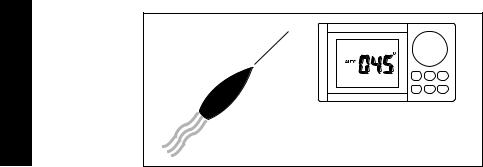
2 Using the RayPilot 650
8 |
RayPilot 650 Control Unit - Owner’s Handbook |
2.2 Auto mode
When the autopilot is in Auto mode it will maintain the boat on a selected magnetic heading.
To enter Auto mode, simply steer the boat onto the desired course and then push AUTO - it is that simple. Course changes can be made by adjusting the knob so that the required new heading is displayed. The RayPilot 650 will then automatically turn the boat onto the new course. The maximum rate of turn is governed by a preset turn limit, so even large course changes at speed are accomplished safely.
045˚
D850-1
Features
In Auto mode, the RayPilot 650 displays the following information:
•AUTO legend
•compass heading
•rudder angle
•boat speed (if available)

Chapter 2: Using the RayPilot 650 |
9 |
2.3 Navigation (Track) mode
Navigation mode relies on the input of your waypoint or route of waypoints to provide tracking to destinations. Navigation mode is the ultimate autopilot facility. Set up a waypoint or route of waypoints on your navigation aid and the pilot will now monitor cross track error and automatically execute course changes to maintain the boat’s heading towards the target waypoint.
We have developed this combination with safety utmost in mind. |
|
|
|
When you reach your target waypoint, the RayPilot 650 will sound an |
|
||
alarm and display the bearing to the next waypoint along with the |
|
|
|
direction in which the boat will turn. You then check to see the turn |
2 |
||
can be made safely. Now press the NAV key to turn the boat on course |
|||
Using |
|||
for the next waypoint. This assures that no sudden course changes are |
|||
made without your knowledge. |
|
||
|
the |
||
|
|
||
003 |
D851-1 |
RayPilot |
|
|
|||
002 |
|
650 |
|
|
|
||
001 |
|
|
|
000 |
|
|
|
Features |
|
|
|
In Navigation (Track) mode, the RayPilot 650 displays the following information:
•NAV legend
•cross track error (XTE)
•target waypoint bearing, distance and number
•direction to steer
•boat speed (if available)
•locked compass heading
•rudder angle (selectable)

10 |
RayPilot 650 Control Unit - Owner’s Handbook |
2.4 Power steer
2 Using the RayPilot 650
D853-1
Power steer mode allows full control of the boat’s helm via the course change knob. If you require helm to port simply rotate the knob to port, helm to starboard turn the knob to starboard. The RayPilot 650 provides a continuous display of rudder position, allowing you to position the helm accurately for steering in any situation.
Features
In Power Steer mode, the RayPilot 650 displays:
•POWER STEER legend
•compass heading and rudder angle
•boat speed (if available)
2.5Manual override (AutoRelease) - sterndrives only
Manual override is automatically enabled when vessel type 4 (sterndrive) is selected. It must only be used on installations fitted with the stern drive actuator. When it has been selected, the RayPilot can be overridden to allow hand steering by turning the steering wheel. This will return the RayPilot to Standby mode and sound the control unit buzzer for 10 seconds.
There is a slight delay before the Raypilot will return to Standby.
Excessive force is not required and will not reduce this delay.
CAUTION:
The manual override is intended for emergency use only. The RayPilot should normally be disengaged by pressing STBY on the control unit.
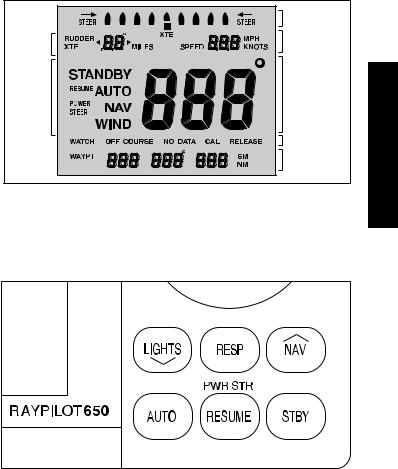
Chapter 2: Using the RayPilot 650 |
11 |
2.6 Display and keypad
Display
The RayPilot 650 display is designed to provide concise, clear information. The display can be illuminated for night time operation.
|
Cross Track Error |
|
|
or Rudder Angle |
|
Selectable |
Boat Speed |
|
Rudder/XTE |
||
|
||
Autopilot |
Heading |
|
Mode |
||
|
||
|
Alarms |
|
|
Target Waypoint |
|
|
Information |
|
|
D854-1 |
Keypad
The RayPilot 650 keypad is designed for quick and simple operation. Each time a key is pressed a single audio beep confirms entry. The 6 keys have adjustable backlighting for night-time operation.
650 RayPilot the Using 2
D856-1

12 |
RayPilot 650 Control Unit - Owner’s Handbook |
Key functions
The following section describes the operation of each key and provides a useful look-up reference.
AUTO
2 Using the RayPilot 650
D857-1
•Momentary press to engage automatic steering and maintain current heading.
•Momentary press in calibration will advance the display to the next calibration feature.
•Momentary press in Auto mode will reset the 4 minute watch alarm timer (if running).
•Momentary press in compass correction mode will change between compass correction and alignment.
STBY
D858-1
•Press to disengage the pilot for manual hand steering. (The previous automatic heading will be memorized).
•Press and hold for 2 seconds to select rudder gain adjustment.
•Press and hold for 4 seconds to select compass heading alignment.
•Press and hold for 6 seconds to view software version.
•Press and hold for 16 seconds to access Calibration mode.
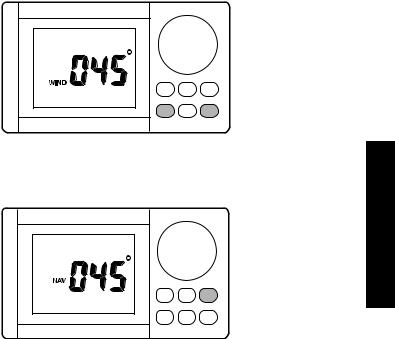
Chapter 2: Using the RayPilot 650 |
13 |
AUTO and STBY
D5661-1
•Press AUTO and STBY together from any other mode to enter Wind Vane mode
NAV
D859-1
•Momentary press (while in Auto or Wind Vane Mode) flashes the display between bearing to waypoint and direction the vessel will turn.
•Second press within 10 seconds of the first press will engage Navigation (Track) mode and turn the pilot onto the bearing to the first waypoint.
•Press and hold for 2 seconds to automatically select the next waypoint in a route (Raychart or SeaTalk compatible plotter/GPS). This will also advance the Target waypoint on the Raychart if equipped.
650 RayPilot the Using 2
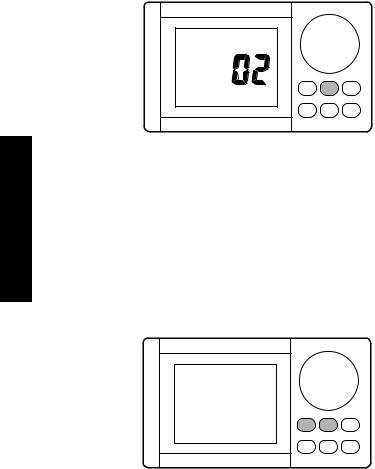
14 |
RayPilot 650 Control Unit - Owner’s Handbook |
RESP
2 Using the RayPilot 650
D860-1
•Momentary press to display current rudder gain level.
•Press and hold for 2 seconds to display current response level.
•You can then make temporary adjustments to the displayed values using either:
•LIGHTS ▼to decrease the level
•NAV ▲to increase the level
•or the course change knob
Note: You can make permanent adjustments to response and rudder gain in Calibration mode.
LIGHTS and RESP
D1007-1
•Momentary press of LIGHTS and RESP together will switch on the Watch Alarm timer (not available from Standby or Power Steer modes).
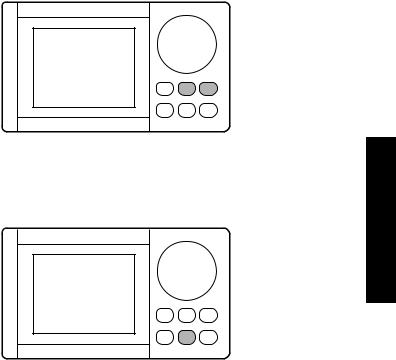
Chapter 2: Using the RayPilot 650 |
15 |
RESP and NAV
D1008-1
•Momentary press of RESP and NAV together will switch the display between cross track error and rudder angle (displayed value and scale).
RESUME (PWR STR)
D862-1
•From Standby mode:
•press to display the last automatic heading – the heading will alternate with the direction you have to steer
•press again within 10 seconds to lock onto the last automatic heading
•From Wind Vane mode:
•press to display the last locked wind angle and direction
•press again within 10 seconds to return
•Press RESUME for 2 seconds to engage Power Steer mode from any mode (except calibration, compass correction and joystick manual).
650 RayPilot the Using 2
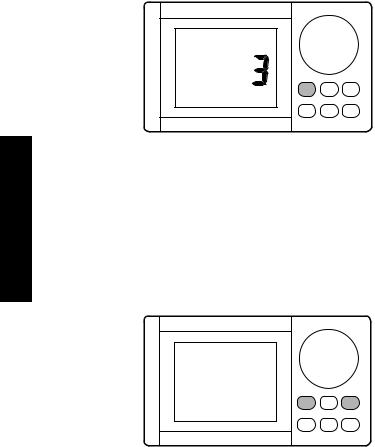
16 |
RayPilot 650 Control Unit - Owner’s Handbook |
LIGHTS
2 Using the RayPilot 650
D861-1
•Push LIGHTS to switch on and adjust the display and keypad illumination:
•0 = Off
•1 = Minimum level
•2 = Medium level
•3 = Maximum level
•Press for 2 seconds to select display contrast adjustment, of which there are 2 levels.
▲(NAV) and ▼(LIGHTS) keys
D862-1A
•Push to increase or decrease any adjustable function.

Chapter 2: Using the RayPilot 650 |
17 |
Course change knob
D863-1
•Adjusts locked heading
•Adjusts heading in Compass Correction mode
•Moves rudder in Power Steer mode
•Adjusts values in Calibration mode
Watch alarm
The RayPilot 650 has a built in Watch Alarm. This is a timer that flashes after 3 minutes and sounds an alarm on each control unit a minute later. To silence the alarm and reset the watch alarm to
4 minutes, press a key or rotate the course change knob.
Note: Watch alarm is not available in Standby or Power Steer modes.
To enable/disable the watch alarm press LIGHTS and RESP together momentarily.
650 RayPilot the Using 2
D1007-1

2 Using the RayPilot 650
18 |
RayPilot 650 Control Unit - Owner’s Handbook |
2.7Response control
Adjusting response – Type 150G/400G
The main way you can adjust the performance of Type 150G/400G (GyroPlus) autopilot systems is by changing the response level. This is the only user adjustment you should need to make to the autopilot on a regular basis.
The response level controls the relationship between the autopilot’s course keeping accuracy and the amount of helm/drive activity. Type 150G and 400G autopilot systems have 9 levels of response:
•level 1 gives the least pilot activity to conserve power, but may compromise short-term course-keeping accuracy
•levels 4 to 6 should give good course keeping under normal operating conditions – with crisp, well controlled turns but without being over-aggressive
•level 9 gives the tightest course keeping and greatest rudder activity, but may lead to a rough passage in open waters as the autopilot may ‘fight’ the sea
When you require extra tight course keeping (e.g. for pilotage in confined and sheltered waters), increase the setting. If you want to minimize drive activity and conserve battery power, decrease
the setting.
You can adjust the default response level in Calibration mode. This determines the default power-up response level. However, when using your autopilot on a day-to-day basis, you can make temporary adjustments to the response level. By doing this you can match autopilot performance to different conditions.
Temporary changes to response – Type 150G/400G
With these points in mind, you should use the following procedure to make temporary adjustments to the response level when required:
1.Display the RESPONSE screen by pressing RESP for 2 seconds.
2.Use the ▲(NAV) or ▼(LIGHTS) key or course change knob to change the response level.
3.Wait for 5 seconds to return to the previous display.
Note: You will lose these temporary changes to response level whenever the system is powered off. You can make permanent adjustments in Calibration mode.

Chapter 2: Using the RayPilot 650 |
19 |
Adjusting response – Types 150/400 and 100/300
To adjust the performance of Type 150/400 (without GyroPlus) and Type 100/300 autopilot systems you can change the response level.
Response level – Types 150/400 and 100/300
The response level controls the relationship between the autopilot’s course keeping accuracy and the amount of helm/drive activity.
You can adjust the default response level in Calibration mode. This determines the default power-up response level.
However, when using your autopilot on a day-to-day basis, you will need to make temporary adjustments to the response level. By doing this you can match autopilot performance to different conditions.
Type 150/400 (without GyroPlus) and Type 100/300 autopilot systems have three different response levels:
•Response Level 1: AutoSeastate on (Automatic deadband)
This setting causes the autopilot to gradually ignore repetitive boat movements and only react to true variations in course. This provides the best compromise between power consumption and course keeping accuracy, and is the default calibration setting.
•Response Level 2: AutoSeastate off (Minimum deadband)
This setting provides tighter course keeping. However, this results in increased power consumption and drive unit activity.
•Response Level 3: AutoSeastate off + yaw damping
This setting provides the tightest possible course keeping by introducing counter rudder yaw damping. You can adjust the counter rudder setting in Calibration mode.
To make a temporary change to the response setting:
1.Display the RESPONSE screen by pressing the RESP keys for 2 seconds.
2.Use the ▲(NAV) or ▼(LIGHTS) key or course change knob to change the response between levels 1 to 3.
3.Wait for 5 seconds to return to the previous display.
Note: You will lose these temporary changes to response level whenever the system is powered off. You can make permanent adjustments in Calibration mode.
650 RayPilot the Using 2
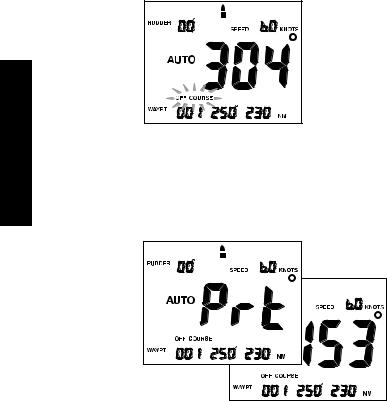
2 Using the RayPilot 650
20 |
RayPilot 650 Control Unit - Owner’s Handbook |
2.8 Alarms and warnings
The RayPilot has a number of warning alarms that can be displayed. An audible alarm will also sound at the same time.
Off Course alarm
D987-1 |
The Off Course alarm sounds in Auto, Navigation (Track) and Wind Vane modes when the current compass and the locked pilot heading differ by more than the setting in calibration for a period of 20 seconds.
Waypoint Change alarm
D988-1A |
The Waypoint Change alarm sounds in Navigation (Track) mode when the target waypoint from the navigation aid changes.
The display alternates between the direction the boat will turn and the bearing to the next waypoint in the route.
